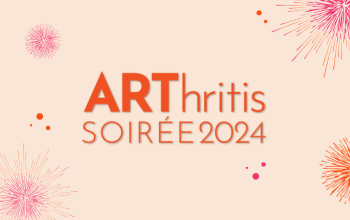News
Growing up with Arthritis: Lori MacLean’s Story
By the time she was three, Lori MacLean had been to more doctor appointments, taken more medications, and felt more pain than many experience in a lifetime.
“My mom noticed lumps on my wrists and ankles when I was around eight months old,” MacLean said. “The pediatrician told her to wait and see…that they might go away on their own. But the lumps got bigger.”
MacLean was diagnosed with rheumatoid arthritis (RA) – an inflammatory disease that affects around 300,000 Canadians of all ages – when she was only two years old.
“One of my earliest memories was getting cortisone injections,” she said.
This form of treatment involves injecting steroids into joints to relieve inflammation and, while effective, can be painful – especially for small children.
From an early age, MacLean also remembers people staring and wondering about her condition.
“Strangers would ask what was wrong with me because I moved differently. My hands and feet looked different too. My mom would tell them I have arthritis. They would say, ‘my grandma has that.’”
But arthritis is not just a disease of grandparents. In fact, it is the most common chronic disease in children – affecting one in 1,000 children in Canada and 5.6 million Canadians of various ages.
MacLean is passionate about creating awareness about arthritis because there are so many misconceptions around who can get it.
“This disease impacts a lot of children. My goal is to have people walk away and say, ‘I had no idea.'”
A new lease on life
RA took centre stage in MacLean’s life for 36 years. The appointments, the injections, the medications, the pain – she knew nothing else.
“Every day revolved around monitoring my body and determining what I needed to treat,” she said. “Someone without arthritis doesn’t have to do that. They aren’t hyper aware of their body or joints. Those of us with RA…we feel every joint.”
Then, after almost four decades of life with rheumatoid arthritis, MacLean went into remission.
“Remission wasn’t something that ever crossed my mind,” she said. “I thought getting the pain to a minimum and the swelling down was the best outcome. And then I started feeling better and better.”
But for MacLean, the most eye-opening part of remission has been discovering what life is like on the other side of RA. “I didn’t know how my life was different from someone without arthritis,” she said. “I used to wake up and the first thing on my mind was that my knees or wrists ached. Then I would limp to a hot shower to help loosen my joints. Now I can get up and make myself a coffee. I don’t need a shower to be able to move.”
MacLean admits that life with arthritis has its dark days, but she is extremely grateful to her rheumatologist and nurses, as well as local arthritis support groups. She encourages everyone with arthritis to seek support when they need it.
“Arthritis can definitely be depressing at times,” she said. “But I have always surrounded myself with friends who can understand what I’m going through. When I’m feeling down, they know I need to do something fun.”
Rheumatoid arthritis has affected the majority of MacLean’s joints except for her jaw and hips. She even has arthritis in her eyes and, from age 11 to 14, was legally blind. She now has no peripheral vision.
“I spent three years in a veil of fog, but I learned to adapt,” MacLean said. “Not a lot of people realize RA can impact your eyes.”
The changing treatment landscape
MacLean grew up with arthritis, but so did the way doctors treat the disease. When she was a kid, Entrophen – a medication used to relieve pain, fever and inflammation – was one of the few options for treating arthritis.
“It’s basically just a pain reliever,” MacLean said. “Gold injections were another option but my doctor resisted doing them because there was a small chance they could affect my vision.”
But arthritis treatments have advanced significantly since MacLean was diagnosed in 1979.
“It’s because of research that biologics came along and changed the landscape of arthritis treatment,” she said.
MacLean now gets HUMIRA injections and takes methotrexate. She described going for her first HUMIRA injection on a Wednesday and waking up on Thursday to notice the swelling in her wrists had gone down.
“I was shocked that was even possible,” she said. “This is why arthritis research is needed. It changes lives.”


























































